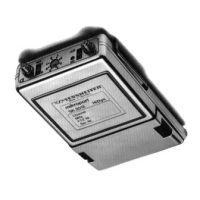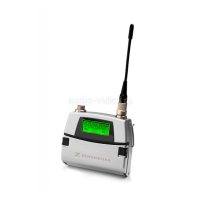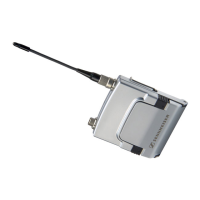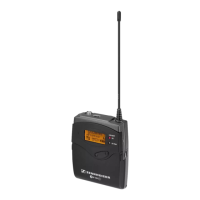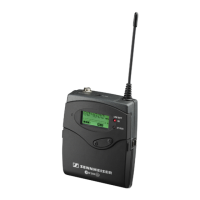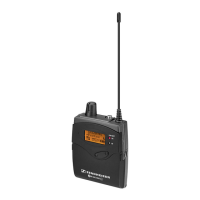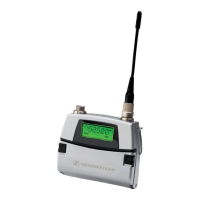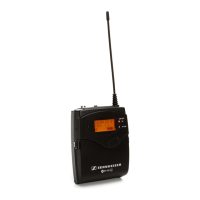Do you have a question about the Sennheiser SK 2000 and is the answer not in the manual?
Guidelines on replacement parts and proper/improper usage of the bodypack transmitter.
Highlights key features of the 2000 series and areas where the transmitter can be used.
Details compatible microphones and instrument cables with their types and pick-up patterns.
Explains the UHF frequency ranges and the structure of frequency banks and channels.
Lists all items included in the SK 2000 bodypack transmitter packaging.
Identifies and describes the main physical components and controls of the transmitter.
Explains the various standard displays and their meanings on the bodypack transmitter.
Guides on inserting batteries/accupack and charging the accupack.
Details how to connect external audio sources using the 3-pin special audio socket.
Instructions for using the belt clip to secure the bodypack transmitter to clothing.
Steps to power the transmitter on/off, including RF mute activation.
Procedure to temporarily unlock the transmitter for menu access or operation.
How to use the MUTE switch for audio muting or RF signal deactivation.
Describes how to cycle through and choose different standard display views.
Explains the function of control buttons and outlines the main and advanced menu structures.
Table detailing menu items, their functions, and the pages where they are described.
Guides on navigating menus, selecting items, and storing settings with examples.
How to cancel input, exit menu items, or return to the standard display.
Introduction to the main menu ('Menu') and its adjustable settings.
Detailed steps for adjusting the input sensitivity level of the transmitter.
Describes sensitivity effects and provides optimal setting recommendations.
Guide to manually selecting frequency banks and channels for transmission.
Explains the types and channels within factory-preset and user-programmable frequency banks.
Procedure for assigning a user-defined name to the bodypack transmitter.
Instructions on how to activate or deactivate the automatic lock feature to prevent accidental changes.
Introduces the advanced menu options for further configuration and customization.
Details on setting transmission frequencies for user-programmable frequency banks ('U1' to 'U6').
Configures the function of the MUTE switch for audio muting or RF signal deactivation.
Explains how to adjust the RF transmission power output level in three steps: Low, Standard, High.
Describes the feature for emulating different guitar cable capacities to alter sound characteristics.
How to enable or disable the pilot tone feature for squelch control and interference protection.
Instructions for adjusting the display's contrast level in 16 steps for better readability.
Procedure to reset operating menu settings to default values, excluding pilot tone and specific frequency banks.
Information on how to view the current software version of the bodypack transmitter.
Steps for synchronizing the transmitter with a receiver for single-device operation, including manual methods.
Guidelines for safely cleaning the bodypack transmitter to avoid damage from liquids or solvents.
Tips for optimal use, placement, and cable management of Sennheiser clip-on microphones.
Recommendations for proper positioning, pop shield use, and sound inlet direction for headmics.
Tips for optimal handling, antenna placement, and sensitivity adjustment for the bodypack transmitter.
Advice on maximizing transmission range and avoiding receiver overload by managing distances.
A table listing common operational issues, their potential causes, and recommended solutions.
List of optional accessories including accupacks, chargers, cables, and microphones available from dealers.
Technical data for modulation, frequency ranges, transmission frequencies, and switching bandwidth.
Technical data for compander system, frequency response, signal-to-noise ratio, and THD.
General specifications including temperature range, power supply, consumption, operating time, dimensions, and weight.
Details compliance with European directives for EMC, Radio, and Safety (CE marking).
Information on product approvals by Canadian and US regulatory authorities.
Details the pinout and function for the transmitter's 3-pin audio input socket.
Information on the product warranty, RoHS, WEEE, and Battery Directives.
States CE marking and compliance with the R&TTE Directive, with declarations available online.
Details compliance with FCC Part 15 and RSS-210 for radio transmission, including user guidance.
| Frequency range | 80 - 18000 Hz |
|---|---|
| Signal-to-Noise Ratio (SNR) | 120 dB |
| FM band range | 516 - 865 MHz |
| Product color | Black |
| Handheld remote control | No |
| Connectivity technology | Wired & Wireless |
| Battery type | AA |
| Dimensions (WxDxH) | 82 x 64 x 24 mm |
| HDMI ports quantity | 0 |
| Headphone outputs | 1 |
| Headphone connectivity | 3.5 mm |
| Digital audio coaxial in | - |
| Manual | Yes |
| Weight | 160 g |
|---|
